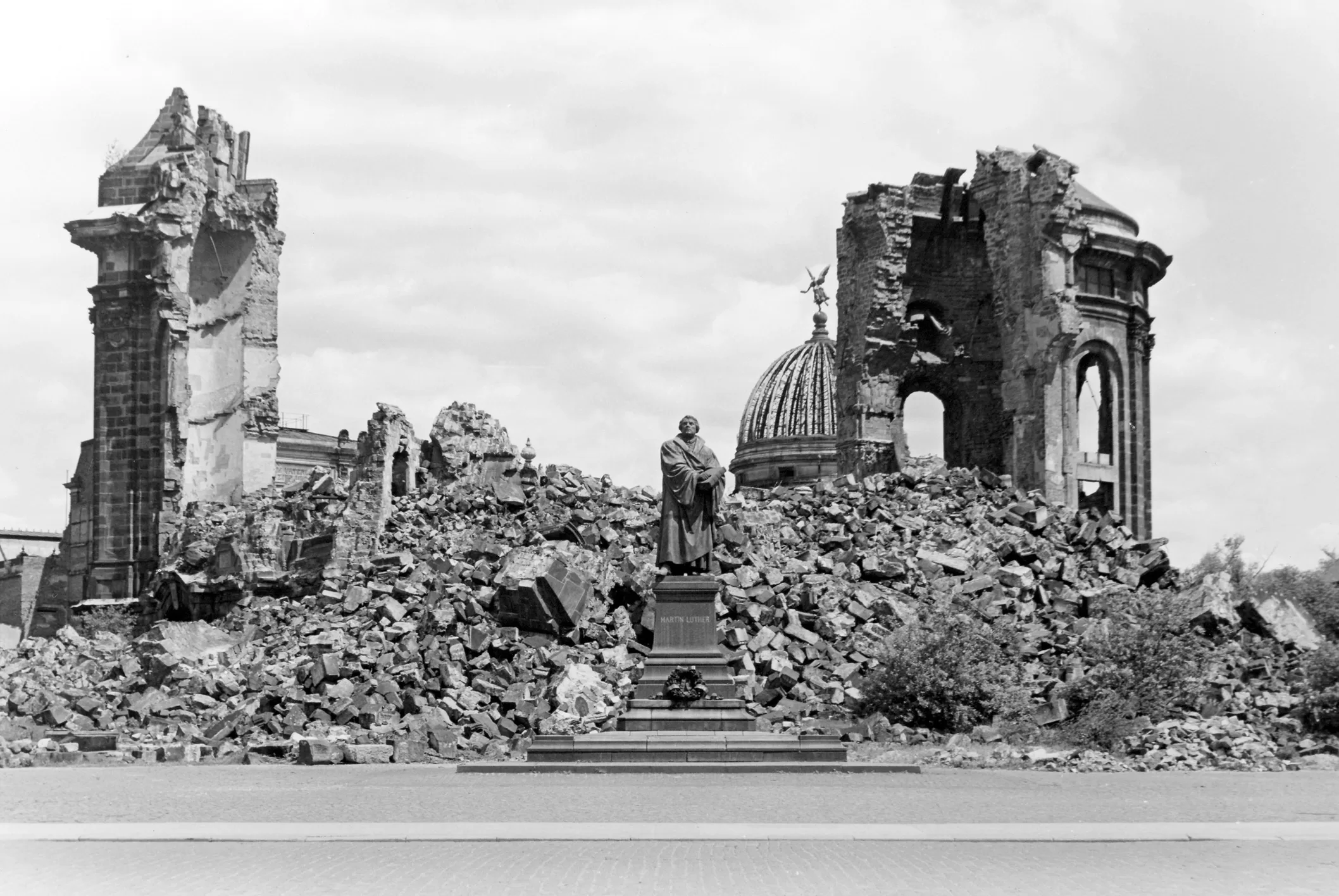In the stillness of night, the hum of aircraft engines shattered the peace above Dresden. Beneath, the city’s inhabitants cowered in fear as bombs rained down upon them, obliterating buildings and claiming lives without distinction. The Americans and British had unleashed a blazing hell upon the city, leaving in their wake only smoldering ruins and a staggering death toll of up to 200,000 souls. This hideous occurrence was naught but a tiny blemish in a war that had already witnessed countless acts of barbarism and genocide. Yet, for the people of Dresden, it was a catastrophic event that inflicted deep wounds and a legacy of agony and suffering that would never fully heal.
In 1969, a peculiar literary work emerged – an autobiographical science-fiction novel authored by the rebellious wordsmith Kurt Vonnegut, titled Slaughterhouse-Five. This literary acid trip followed the surreal journey of Billy Pilgrim, an American POW trapped in the midst of the Dresden bombings. Pilgrim bounced around in time like a crazed pinball, chronicling the atrocities with the detached refrain of “So it goes.” It was as if Vonnegut had found a way to take the fragmented shards of history and reality and meld them together into a cohesive, yet unsettling, whole.
Kurt Vonnegut, a young American soldier, found himself at the mercy of the horrors of war when he was captured during the Battle of the Bulge and sent to Dresden. The city was infamous for its slaughterhouses, numbered from one to twelve, that served as makeshift prisons. These ghastly structures loomed over the meatpacking district that surrounded them, casting a shadow of death and despair. When the Allies unleashed the devastating bombardment on Dresden, dropping nearly 4,000 tons of explosives, Vonnegut sought shelter in the depths of Slaughterhouse 5. This grim edifice, once a symbol of the city’s brutal industrial past, now offered a flicker of hope amidst the chaos and destruction, as Vonnegut clung to life in the face of overwhelming odds.
As Vonnegut emerged from the depths of Slaughterhouse 5, he was met with a scene of unspeakable dread. The city of Dresden lay in ruins, a smoldering heap of rubble and ash. Corpses littered the streets, their twisted limbs and lifeless forms a macabre tribute to the destructive power of war. Vonnegut and his fellow prisoners were given the grisly task of gathering the bodies for a mass burial. But there were too many dead, too many broken and battered bodies to be buried with any semblance of dignity. So the Germans brought in their flamethrowers, burning the dead where they lay in a grotesque display of inhumanity.
Vonnegut’s literary opus caused a stir in the world of letters, earning both critical praise and commercial success that swept through the industry like a tempest. The novel’s scorching condemnation of the futility of war struck a chord with readers who were grappling with the bleak realities of a world on the brink of nuclear obliteration. Set against the backdrop of the Vietnam War, which was rending America apart, Slaughterhouse-Five became a rallying cry for a generation of disillusioned youth who saw through the hollow rhetoric of their leaders and yearned for a world where violence was not the solution.
In his singular way, Vonnegut’s toil cut to the marrow, like the witches’ prophecy in Macbeth. The novel’s incisive critique of the vanity of war resonated with the audience, who struggled to comprehend a world in which savagery and ruin seemed to be the prevailing mode. As though echoing the play’s renowned line, “It is a tale told by an idiot, full of sound and fury, signifying nothing,” Slaughterhouse-Five laid bare the hollowness of the war apparatus and its dehumanizing impact on all who were ensnared by its grip. Like Macbeth, the book spoke to a common truth about the corrupted and violent nature of authority, and its repercussions on those who wield it as well as those who bear its burden.
According to Martin Heidegger, the essence of Being is rooted in its potentiality-for-Being and its capacity for revealing itself through the world. This openness is essential to human existence, enabling us to encounter and create significance in our lives. However, the devastation of cities and the savagery of war depict a constriction of this openness. They obliterate the frameworks that permit the revealing of Being, leaving a void in their wake. This void represents an essential loss of sense and direction and can evoke a sense of angst and nihilism.
In the instance of the conflagration of Dresden, the city’s annihilation signifies a profound forfeiture of Being. Its edifices and traditions were immolated, leaving behind only rubble and confusion. This obliteration embodies a fundamental affront to the openness of Being and the human ability to discern order in chaos. From a Heideggerian perspective, the atrocity of the burning of Dresden lies not solely in the loss of life and destruction of property, but in the crushing of the frameworks that allow for the revealing of Being. It embodies a closing off of the world, a repudiation of the openness that is crucial to human existence. Thus, the disappearance of Dresden is not merely a matter of physical obliteration but the eradication of the very essence of human existence.
Vonnegut’s words cut through the fog of war like a knife, slicing open the raw wound left by his experience of the blazing inferno. He started his novel with the unforgettable phrase “All this happened, more or less,” acknowledging the malleable nature of memory and the impossibility of capturing the full extent of the carnage. For the rest of his life, Vonnegut spoke out about the tragedy, painting a stark portrait of the total assault wrought upon what he deemed “perhaps the most beautiful city in Europe.” His words were a testament to the suffering of those who lived through the bombing and its aftermath, describing the arduous task of recovering buried bodies in terms that were typically candid and uncompromising: “a terribly elaborate Easter-egg hunt.” Through his writing, Vonnegut ensured that the memory of this atrocity would live on, a warning against the grotesque terror of war and the fragility of life itself.
In his customary manner, Vonnegut made a droll remark that he alone might have profited from the ravages of Dresden. He quipped that he earned a pittance of two or three dollars for each soul lost, jesting as if he was engaged in some business. Vonnegut’s sardonic humor, reminiscent of the wit of the ancient Greek epic poet Homer, served as a caustic commentary on the pointless devastation created by war. Like the cunning Odysseus, Vonnegut was a survivor of great adversity and suffering, and his writings were a testament to the unyielding spirit of humanity in the face of calculated disaster. Yet, while Odysseus had to brave the dangers of a treacherous sea and contend with the ire of the gods, Vonnegut had to navigate the equally treacherous landscape of postwar society, where the scars of the past still festered and the shades of the departed still haunted the living.
In the aftermath of the bombing of Dresden, the city was left in ruins, with many of its historical buildings reduced to rubble. Over the years, the city has undergone a painstaking process of reconstruction, with architects and builders working tirelessly to restore many of the city’s iconic structures to their former glory. One such building is Slaughterhouse 5, which has been transformed into Hall 1 of the Dresden Exhibition Center. The building, which was once a sinister symbol of the massacre of beasts, has been completely redesigned to create a modern, sleek venue for conferences and meetings. Despite its modern appearance, the building still retains some of its original architectural features, which can be seen from the outside. Visitors to the city can also catch a glimpse of the structure’s gruesome past, as a simple blue-gray sign bearing its former name serves as a testament to the tragic events that took place there. Although the building is closed to visitors, some are able to persuade the guards to allow them onto the grounds to snap a photo, offering a brief glimpse into the past and a reminder of the enduring resilience of the human spirit.










[…] Quelle: https://arktos.com/2023/03/19/vonnegut-heidegger-and-the-blood-of-dresden/ […]